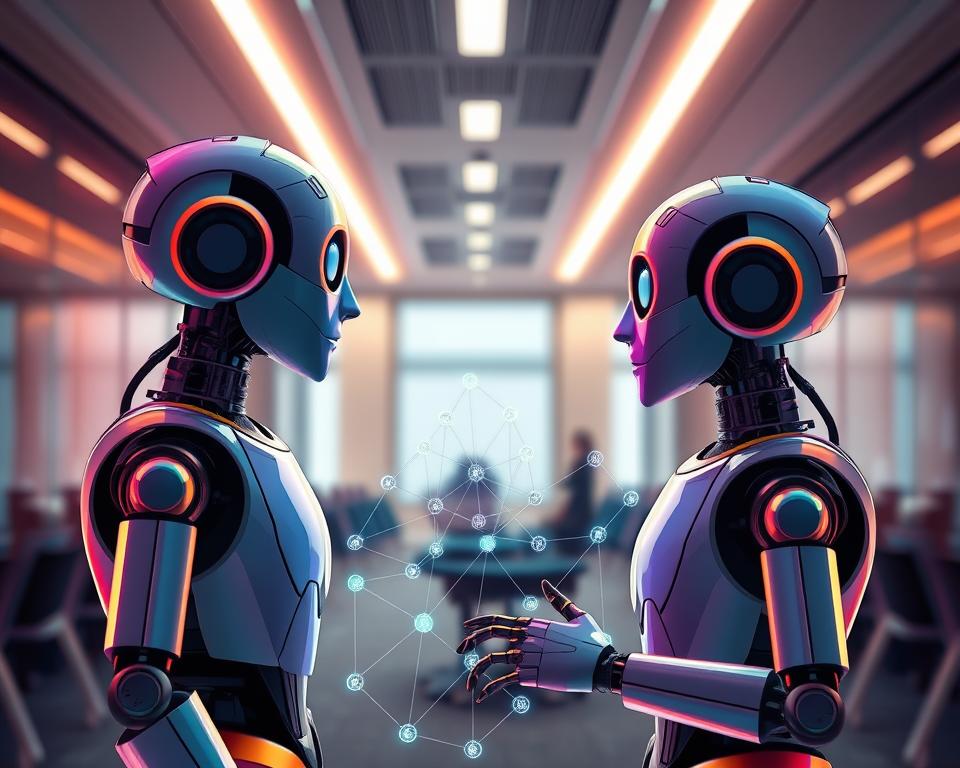In today’s fast world, great customer service is key to keeping customers and growing your business. AI customer service lets companies automate support, making things more efficient and saving money.
AI in customer support means businesses can help customers anytime, answering questions and solving problems fast. By automating customer support, companies can use their people for more important tasks that need a human touch.
Table of Contents
Key Takeaways
- AI-powered customer service can make customers happier.
- Automating support makes things more efficient and saves money.
- Using AI in customer service needs careful planning and doing.
- Businesses get 24/7 help with AI chatbots.
- AI customer service helps build loyalty and grow your business.
The Evolution of Customer Service Automation
Customer service automation has changed a lot. It moved from manual to AI-driven solutions. This change is because of the need for better efficiency, lower costs, and a better customer experience.
From Manual to Automated Systems
The old customer service model relied on people. This caused many problems.
Traditional Customer Service Challenges
Manual customer service was expensive, not always available, and the quality varied. These issues made automation necessary.
Early Automation Solutions
At first, we used IVR systems and simple chatbots. These early attempts improved things a bit but still had their limits and often upset customers.
The AI Revolution in Customer Support
AI has changed customer service automation a lot. It brought new tools like natural language processing and machine learning.
Transformative Impact of AI Technologies
AI lets businesses offer support anytime, respond quickly, and tailor experiences. This has made customers much happier.
Current State of AI in Customer Service
Now, AI chatbots and virtual assistants are everywhere. They handle many customer questions. This lets human agents deal with harder issues.
Understanding AI in the Context of Customer Service
Technology keeps getting better, and AI is now key in making customer service better. It’s not just about using new tech. It’s about making customers happier and making things run smoother.
Defining AI-Powered Customer Service
AI-powered customer service uses artificial intelligence to handle customer questions. It uses machine learning algorithms to get and answer customer queries well.
Core Components of AI Customer Service
The main parts are natural language processing (NLP), machine learning, and working with current customer service systems. Together, they make sure customers have a great experience.
Differences from Traditional Automation
AI customer service is different from old automation. It can really get what customers mean and give them better help. This makes customers much happier.
Key Technologies Driving Automation
The main techs behind AI customer service are machine learning and natural language processing. They help businesses do complex tasks and make talking to customers better.
Machine Learning Fundamentals
Machine learning is a part of AI that trains algorithms on data. In customer service, it helps analyze customer info to make service better.
Natural Language Processing Capabilities
NLP lets computers understand and make human language. In customer service, it powers chatbots and virtual assistants. This gives customers fast and right answers.
Benefits of Using AI to Automate Customer Service
Using AI in customer service has many benefits for businesses and their customers. It automates routine questions and tasks. This makes customer support better.
24/7 Availability and Instant Response
AI-powered customer service is always available and responds quickly. This means customers get help anytime, no matter where they are. A customer service expert says, “AI chatbots can handle lots of questions. This lets human agents deal with harder issues.”
Cost Reduction and Operational Efficiency
AI makes customer service cheaper and more efficient. It takes over simple tasks, so humans can focus on harder ones. A study found that using AI can cut costs by up to 30%.
Scalability During Peak Periods
AI systems grow with demand, handling more questions without slowing down. This keeps customer satisfaction high, even when it’s busy.
Improved Customer Experience and Satisfaction
AI makes customer service better, leading to happier customers. It gives quick, personalized help. An analyst says, “AI is changing how companies talk to customers. It makes them more loyal and keeps them coming back.”
In summary, AI in customer service offers many benefits. It improves availability, efficiency, and customer happiness. By using AI, businesses can greatly enhance their customer support.
Common Challenges and Limitations
Using AI in customer service comes with its own set of challenges. While AI brings many benefits, it also has its own set of hurdles for businesses to overcome.
Handling Complex Customer Issues
One big challenge is dealing with complex customer problems. AI systems are advanced but can struggle with human emotions and complex complaints. This can lead to poor solutions and make problems worse.
For example, a customer might have a complaint that involves many products or services. They need a personal and empathetic response that AI can’t always provide. In these cases, humans are needed to solve the problem right.
Integration with Existing Systems
Another big challenge is making AI work with current customer service systems. This requires making sure AI fits with different software and hardware, which can be hard and slow.
To get past this, companies need to invest in tech that works with AI. They also need to make sure their IT setup can handle AI-powered customer service tools.
Customer Resistance to AI Interactions
Some customers don’t like talking to AI. They might prefer talking to a real person and might be hesitant to use AI for customer service.
| Challenge | Description | Potential Solution |
|---|---|---|
| Complex Issues | AI may struggle with nuanced or complex customer complaints. | Implement human handoff for complex issues. |
| System Integration | Integrating AI with existing systems can be complex. | Invest in compatible technologies. |
| Customer Resistance | Customers may prefer human interaction over AI. | Offer options for human interaction alongside AI. |
By knowing these challenges and finding ways to tackle them, companies can use AI better in their customer service.
How to Use AI to Automate Customer Service: A Step-by-Step Approach
Using AI to automate customer service can make things better for customers and save money. Businesses need a clear plan to make this work.
Assessing Your Customer Service Needs
Before starting with AI, it’s important to look at your current customer service.
Identifying Pain Points
Start by identifying pain points in your current customer service. This might be slow responses, too many simple questions, or not enough help when it’s busy.
Setting Clear Automation Goals
After finding your pain points, set clear automation goals. Decide what you want to achieve, like faster responses or happier customers.
Identifying Automation Opportunities
Next, find areas where you can use AI.
High-Volume, Repetitive Tasks
Look for high-volume, repetitive tasks that AI can handle. This includes answering common questions or directing customer calls.
Customer Interaction Mapping
Customer interaction mapping helps find where AI can help. Map out how customers interact with your service to see where AI can improve things.
Selecting the Right AI Solutions
Now, pick the best AI solutions for your needs.
Vendor Evaluation Criteria
When choosing vendors, look at vendor evaluation criteria. Consider their experience, how well their solutions grow with your business, and if they work with your systems.
Build vs. Buy Considerations
Decide if you should build your own AI solution or buy one. Think about the cost, upkeep, and how customizable it needs to be.
Implementation and Integration Strategies
Getting AI to work well in your customer service needs a good plan for setting it up and making it work with your systems.
Phased Rollout Approach
Use a phased rollout approach to avoid problems and make the change smoothly. Start small and grow as you go.
API Integration Best Practices
Follow API integration best practices for easy setup with your systems. Pick the right APIs, keep data consistent, and make sure it’s secure.
| Step | Description | Key Considerations |
|---|---|---|
| 1. Assess Needs | Evaluate current customer service operations | Pain points, automation goals |
| 2. Identify Opportunities | Pinpoint areas for automation | Repetitive tasks, customer interaction mapping |
| 3. Select AI Solutions | Choose the right AI vendor or solution | Vendor experience, build vs. buy |
| 4. Implement and Integrate | Roll out AI solutions and integrate with existing systems | Phased rollout, API integration best practices |
Building Effective AI Chatbots
AI chatbots are changing customer service by offering quick and personalized help. To make these chatbots work well, businesses need to focus on a few key areas. They must design conversational flows, train with good data, and test and improve their chatbots.
Designing Conversational Flows
Creating conversational flows means making the chatbot talk like a person. It’s about making the dialogue natural so it can understand and answer customer questions.
Creating Natural Dialogue Patterns
To make the chatbot talk like a person, businesses need to study how customers interact. They should look for common things customers say and how they respond. This helps the chatbot have human-like conversations.
Handling Conversation Branches
Handling different customer questions is key. The chatbot needs to be able to adapt to what customers need. This means having a good plan for how the conversation will go.
Training Your Chatbot with Quality Data
Training a chatbot well is very important. It needs good data to learn from. This data should be accurate and relevant.
Data Collection Strategies
To get good data, businesses should collect it from many places. This includes customer chats, feedback, and social media. This helps the chatbot understand and meet customer needs.
Continuous Learning Models
Chatbots should keep learning from customers. This means they can get better over time. They need a strong system to analyze what customers like and don’t like.
Testing and Optimization Strategies
Testing and improving chatbots is crucial. It’s about testing different versions to see which one works best. This helps find the best way to design the chatbot.
A/B Testing Approaches
A/B testing means comparing different chatbot designs. This could be how they talk or how they answer questions. It helps find the best design for the chatbot.
User Feedback Integration
Using customer feedback is important. It helps improve the chatbot. A good feedback system can find out what needs to get better.
“The key to successful AI chatbots is to create a seamless and intuitive conversation that makes customers feel like they’re interacting with a human.” –
Implementing AI-Powered Email Response Systems
Using AI to automate email responses is key for businesses wanting better customer service. AI systems help cut down on how long it takes to reply and make customer interactions more accurate.
Auto-Classification of Customer Emails
Sorting customer emails with AI is a big part of these systems. Algorithms sort emails based on what they say and why the customer sent it.
Email Intent Recognition
Understanding why a customer sent an email is crucial. This lets the system send emails to the right place and respond correctly.
Priority Assignment Algorithms
These algorithms make sure emails are handled in the right order. This keeps customer emails organized and ensures urgent ones get attention fast.
Smart Response Generation and Routing
After sorting, AI systems can create the right responses or send emails to the right teams. This makes handling emails more efficient.
Template-Based Response Systems
These systems use pre-made templates for common questions. It makes customer service faster and more consistent.
Dynamic Content Generation
This feature makes responses more personal by using customer data. It makes customers feel like they’re getting information just for them.
AI-powered email systems can really help businesses improve their customer service. They make responses faster and more personal, making customers happier.
Voice AI for Customer Service
Voice AI is changing customer service for the better. It makes support more efficient and personal. This change comes from new tech in Interactive Voice Response (IVR) systems, voice recognition, and voice biometrics.
Interactive Voice Response (IVR) Systems
IVR systems are key in Voice AI. They let customers talk to a company’s phone system. They can handle calls, give info, and even do simple transactions.
Voice Recognition and Analysis
Voice recognition tech lets AI systems get what customers say. This means businesses can offer service that really understands and cares. It makes customers happier.
Voice Biometrics for Authentication
Voice biometrics uses unique voice traits to check who’s calling. It makes customer service safer and cuts down fraud. It also makes checking who you are quicker and easier.
| Feature | Description | Benefit |
|---|---|---|
| IVR Systems | Automated voice interaction | Reduced wait times |
| Voice Recognition | Understanding customer queries | Personalized service |
| Voice Biometrics | Secure customer authentication | Enhanced security |
A customer service expert says, “Voice AI in customer service is more than just automation. It’s about making interactions feel human, efficient, and personal.” Voice AI is set to change customer service for the better, making it more efficient, secure, and focused on the customer.
Data Privacy and Ethical Considerations
AI is changing customer service, but we must focus on data privacy and ethics. We need to balance efficient service with protecting customer data.
Protecting Customer Information
Keeping customer data safe is key in AI customer service. We must make sure AI systems handle data with strict privacy rules.
Compliance with Privacy Regulations
Following laws like GDPR and CCPA is crucial. Companies must make sure their AI meets these standards to avoid legal issues and keep customer trust.
Data Minimization Principles
Data minimization means AI should only use data it really needs. This reduces the chance of data leaks and keeps customer info safe.
Ethical AI Development and Deployment
Creating and using AI ethically is essential. It helps keep customer trust and makes sure AI works for everyone’s good.
Transparency in AI Decision-Making
Transparency in AI decision-making is vital. Customers should know when they’re talking to AI, and AI’s choices should be clear and fair.
Avoiding Bias in Customer Interactions
It’s important to avoid bias in AI interactions. AI systems must be made and trained to treat everyone equally, without prejudice.
By focusing on data privacy and ethics, companies can gain customer trust. This is crucial for the success of AI in customer service.
Personalization Through AI
AI is changing customer service by making it more personal and engaging. It analyzes lots of customer data to create experiences that fit each person’s needs.
Customer Data Analysis for Personalized Experiences
Good personalization starts with understanding customer data. This means collecting and studying data on what customers do, like, and interact with.
Creating Customer Profiles
AI makes detailed customer profiles by combining data from different places. These profiles help businesses know what customers like and offer better services.
Behavioral Analysis Techniques
AI uses advanced techniques to guess what customers will do and like. This lets businesses offer services that customers will appreciate before they even ask.
Predictive Customer Service Models
Predictive customer service models use AI to guess what customers need and help them before they ask. This makes customers happier and helps businesses work better.
Anticipating Customer Needs
AI looks at past data and current interactions to guess what customers might need next. This way, businesses can solve problems before customers even notice they have one.
Proactive Support Strategies
AI helps businesses spot problems before they get big. This means they can help customers even before they know they need it.
| Personalization Aspect | AI-Driven Technique | Customer Benefit |
|---|---|---|
| Customer Profiling | Data Aggregation and Analysis | Tailored Experiences |
| Predictive Support | Behavioral Analysis and Prediction | Proactive Issue Resolution |
| Personalized Recommendations | Machine Learning Algorithms | Relevant Offers and Solutions |
Balancing AI and Human Touch
As businesses use AI for customer service, finding the right mix is key. It’s important to blend AI with human empathy and understanding. This balance makes customer service successful.
Creating Seamless Human-AI Handoffs
To smoothly switch between AI and human agents, focus on good handoff processes. This means:
- Knowing when to pass on to human agents
- Keeping customer info consistent during the switch
Identifying Escalation Triggers
Escalation triggers help decide when to switch from AI to human help. These include complex complaints, special requests, and when AI can’t get the customer’s point.
Context Preservation During Transfers
Keeping customer context during the AI to human switch is crucial. This is done by keeping a detailed record of their history. This way, human agents have all the info they need.
Training Human Agents to Work with AI
For humans to work well with AI, they need special training. This training should cover:
- New skills for working with AI, like understanding its limits
- How to work together with AI to help customers
New Skills for the AI-Augmented Workplace
In a world with more AI, customer service agents need new skills. These include empathy, critical thinking, and solving complex problems.
Collaborative Workflows
Workflows that combine human and AI efforts can greatly improve service. For example, AI can analyze data to offer personalized help. Then, human agents can use this info to give more tailored support.
Measuring the Success of AI Customer Service
It’s important to know how to measure AI customer service success. As more businesses use AI for customer service, checking its performance is key.
Key Performance Indicators (KPIs)
KPIs help us see how well AI customer service is doing. They show us how the AI is working and where it can get better.
Automation Rate Metrics
Automation rate metrics show how many customer questions AI answers on its own. A high rate means AI is working efficiently.
Resolution Time Improvements
Resolution time metrics track how fast AI solves customer problems. Quick solutions make customers happier.
Customer Satisfaction Metrics
Customer satisfaction is key to measuring AI success. Scores like CSAT and NPS give us insights into what customers think.
CSAT and NPS Measurement
CSAT and NPS scores tell us how happy customers are. They help us see if our AI service meets their needs.
Sentiment Analysis of Feedback
Sentiment analysis looks at customer feedback to find the emotional tone. It helps us see where our AI service can get better.
ROI Calculation for AI Implementation
Figuring out the ROI of AI customer service is important. It helps justify the costs of using AI.
Cost Savings Analysis
Cost savings analysis compares AI service costs to old methods. Big savings show AI is a success.
Long-Term Value Assessment
Long-term value looks at AI’s ongoing benefits. It considers things like keeping customers and building loyalty.
Case Studies: Successful AI Customer Service Implementation
Many companies have used AI to boost their customer service. This has led to happier customers, lower costs, and better efficiency.
Retail Industry Examples
The retail world has greatly benefited from AI in customer service. AI has changed how retailers talk to their customers, from online support to in-store help.
E-commerce Support Automation
Online shops use AI chatbots to answer customer questions fast. For example, Amazon helps with order tracking and product suggestions using AI.
In-Store Digital Assistance
Physical stores use AI to improve customer service. Walmart has digital helpers in some stores to guide customers and find products.
Banking and Financial Services
The banking world has also seen big gains from AI in customer service. AI helps with fraud detection, account management, and more.
Fraud Detection and Resolution
Banks like JPMorgan Chase use AI to spot and fix fraud quickly. This makes customers feel safer and more trusting.
Account Management Automation
AI automates tasks like checking balances and transaction history. This lets human agents deal with harder issues.
Telecommunications and Technology Companies
Telecom and tech firms use AI for better technical support and service upgrades.
Technical Support Optimization
Companies like AT&T use AI chatbots for tech support. This cuts down wait times and boosts success rates.
Service Upgrade Recommendations
AI analyzes data to suggest service upgrades. This makes customers happier and more loyal.
| Industry | AI Application | Benefits |
|---|---|---|
| Retail | E-commerce Support Automation | Reduced response times, improved customer experience |
| Banking | Fraud Detection and Resolution | Enhanced security, improved customer trust |
| Telecommunications | Technical Support Optimization | Reduced wait times, improved resolution rates |
Future Trends in AI Customer Service
New technologies are changing AI customer service. They make businesses talk to customers in new ways. This leads to better and faster support.
Emerging Technologies and Innovations
New tech is shaping AI customer service. Key areas include better conversational AI and more ways for customers to interact.
Conversational AI Advancements
Conversational AI is getting smarter. It lets customers and AI systems talk more naturally. This makes customer experiences smoother.
Multimodal Customer Interactions
Multimodal interactions mix text, voice, and visuals. They let customers choose how they want to interact. This makes them happier.
Preparing for the Next Generation of Customer Support
Businesses need to get ready for the future. They should focus on training teams and planning for AI updates.
Skill Development for Future Support Teams
Support teams need skills that match AI’s growth. They should learn about empathy, problem-solving, and tech.
Strategic Planning for AI Evolution
Businesses must plan for AI’s future. They should keep up with AI tech and use it in their customer service plans.
| Trend | Description | Impact |
|---|---|---|
| Conversational AI | More natural interactions | Improved customer experience |
| Multimodal Interactions | Combining text, voice, and visuals | Enhanced customer satisfaction |
| Skill Development | Training for support teams | Better human-AI collaboration |
Conclusion
AI is changing customer service by giving businesses tools to automate and improve support. It’s important to understand how AI works, its benefits, and challenges. This knowledge helps companies use AI to better serve their customers.
There are steps to follow to use AI well. First, figure out what your customers need. Then, pick the right AI tools. Finally, set up AI chatbots and email systems to make things more efficient and save money.
It’s key to mix AI with a human touch. This way, businesses can offer personalized service. This approach is essential for keeping customers happy and loyal.
This summary shows how AI can change customer support. By using AI, businesses can improve customer satisfaction and loyalty. This leads to success in the long run.



















